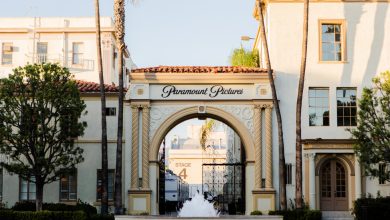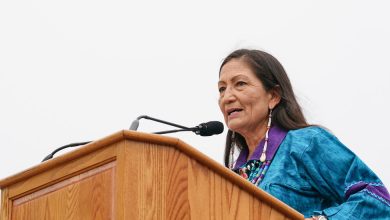Sam Waterston Is Still the Face of ‘Law & Order’

“Law & Order” premiered on NBC in 1990. A procedural that was really two procedurals conjoined, the first half of each episode focused on the investigation of a crime, the second on the prosecution of the accused. Among the original cast members was Michael Moriarty, who played an assistant district attorney. During the fourth season, under clouded circumstances, Moriarty left.
As Dick Wolf, who created “Law & Order,” tells it, Warren Littlefield, NBC’s president, questioned whether the show could continue. Wolf thought that it could. “I’ve got two words for you,” he says he told Littlefield. Those words? “Sam Waterston.”
Waterston, who had just wrapped the NBC civil rights drama “I’ll Fly Away,” hadn’t been looking for a procedural. Having begun his career as a classical actor, he never really expected to work in television. Still, he agreed — in the short-term, anyway — signing a one-year contract in 1994 to play the principled assistant district attorney Jack McCoy.
“I didn’t think I’d be there long,” Waterston recently told me. He stayed for 16 seasons. In those years, “Law & Order” became a cultural touchstone and an extensive franchise (back before seemingly every procedural franchised). Waterston — as his hair silvered and his face cragged — remained its dependable face.
When NBC canceled the show, in 2010 — its ratings by then less than half of its early ’00s peak — he went back to classical theater and took prominent roles in Aaron Sorkin’s HBO media drama, “The Newsroom,” and in the Jane Fonda-Lily Tomlin Netflix comedy “Grace and Frankie.” He made a few movies. And then in a twist that even a late-season “Law & Order” writers room might have considered too much, “Law & Order” suddenly returned after a decade away, with Waterston’s McCoy along for the prosecutorial ride.
The first episode will premiere on Feb. 24 on NBC (and available to stream the following day on Peacock and Hulu). And on March 3, Hulu will debut “The Dropout,” a limited series based on the Theranos scandal, in which Waterston plays the former Secretary of State George Shultz. The seventh and final season of “Grace and Frankie” arrives in April, which means that Waterston will have three shows on simultaneously, showcasing his talents for drama, sophisticated impersonation and light comedy.
“This is a really sweet time,” he said, as he tidily sipped a bowl of chicken soup. “I’ve always wanted to prove that I can do all kinds of things.” His motto, he told me, is a lyric from the musical “A Chorus Line” about an actor’s desire to do it all: “I can do that! I can do that!” Now he has.
This was on a recent weekday afternoon. The forecast had predicted rain — correctly. But Waterston, 81, had still insisted on meeting in Central Park, armed against the wintry mix in a broad-brimmed hat, a leather jacket and an umbrella that he mostly left furled. He had brought me and a photographer to the Delacorte Theater, the longtime home of Shakespeare in the Park and the site of his early career triumphs: Benedick in “Much Ado About Nothing,” the Duke in “Measure for Measure,” Hamlet in “Hamlet.”
“His love of that place, you could feel it very tangibly,” Michael Greif, who directed him there in “The Tempest,” told me. It was true. Waterston strode around stage — cheeks reddening, eyes crinkling — like it was summer already, seeming to see not the slush but the work he had done over the past 60 years.
“The Delacorte just got the green light to be completely rebuilt,” he said in a nearby Italian restaurant, where we had retreated, damply. “It’s simply too great.”
Waterston — plain-spoken, twinkly, wistful — has never needed much in the way of renovation, though he has reinvented himself as an actor several times over. His trip to the Delacorte suggested a man trying to trace a through-line in a hectic career.
“What’s cool about this age is that you can look back at all that and appreciate that it actually was worth doing,” he said.
Precocious, he started early, playing a small part in a play directed by his father, who taught at a preparatory school in northwest Massachusetts. At Yale, he continued acting; he can still recall a magical night in which he played Lucky in “Waiting for Godot” and felt that he and the audience “were in this kind of incredible bubble of communication and understanding of each other.” (This was after the Yale Daily News had argued he was too smart for the part, Waterston recalled.)
He couldn’t imagine a career in show business — “a crazy business,” he called it. At Yale, he studied more sensible subjects like French and history. He spent a year at the Sorbonne. But somehow he couldn’t stop himself.
“It’s endless fun,” he said. “When you compare it to other kinds of work, why would you want to do anything else?”
At first the roles that came to him were mostly comic, owing perhaps to his gangling figure and pilgrim looks — long face, sharp nose, superb eyebrows. He looks a lot like a handsome Abraham Lincoln. Waterston disputes the “handsome” part.
Dramatic roles came a few years later. Then there were movies, then television, where he often played parts based on real people — Lincoln and others. (“People knew by then that I like to do Shakespeare. And if I liked to do Shakespeare, I must be serious,” he said.) Even as he angled to show his range, some constants remained, like a keen interest in characters in the midst of a moral quandary and a flair for the theatrical leavened by a natural gravitas.
“For all his training, he has this incredible ability to be quiet onscreen,” said Elizabeth Meriwether, the showrunner of “The Dropout.” “You can tell he’s thinking onscreen, which is really rare.”
And no matter the role, he seemed like a man you could trust. Stephen Colbert at one point introduced him as “the most reasonable seeming man in America.”
“Law & Order” came around just as he was worrying how we would pay for four college educations. (He has one child, the actor James Waterston, with his first wife, Barbara Rutledge Johns; and three children, the actresses Elizabeth Waterston and Katherine Waterston and the filmmaker Graham Waterston, with his current wife, Lynn Louisa Woodruff.) The salary was decent and the show filmed in New York City, not too far from his Connecticut farmhouse.
“It was just exactly the right moment,” he said. “And it kept me out of trouble. Kept me from doing really dumb stuff.”
What dumb stuff, exactly?
“Well, who knows what the dumb stuff would have been,” he said. “But we all know that there’s a lot of dumb stuff.”
Of course, “Law & Order” did more than preclude Waterston’s midlife crisis. Popular, influential and respectful of its audience, it made stars of many of its cast members. Even its scene break sound effect — the gavel-like “dun-dun” — became famous.
Within a decade, it had birthed a litter of spinoffs, including one show, “Law & Order: Special Victims Unit,” that went on to displace “Gunsmoke” as the longest running television drama ever. (If there’s one thing America loves more than crime, it seems, it’s sex crime.) It helped to reestablish New York City as a viable hub for scripted series, drawing on its deep bench of theater actors. Everyone who’s anyone can list at least one “Law & Order” credit in a Playbill bio.
The two-part format of “Law & Order,” which Wolf has described as a murder mystery followed by a moral mystery, proved indestructible. Every member of the original cast departed and still “Law & Order” kept going. (Even after cancellation, the original never really left. On TNT, it runs and runs in syndication.) Still, certain characters — Waterston’s McCoy, Jerry Orbach’s Lennie Briscoe (12 seasons), S. Epatha Merkerson’s Anita Van Buren (17 seasons) — became metonyms for the show itself: hardworking, upstanding, bent on justice.
The format depends on fixed structures and rhythms. In the early seasons, McCoy had similar scenes in nearly every episode: cross-examinations, in-chambers meeting, closing arguments. That could have made for repetitiveness, but in Waterston’s hands, the formula rarely felt formulaic.
“He makes the role and the words unendingly interesting,” Wolf told me in an all-caps email. “That takes a level of skill and humanism that not many people possess.”
After 12 seasons, the pace had worn him down, and he was happy enough, in 2007, to move into the less demanding role of district attorney, leaving the trial scenes to younger actors. Sometimes, during those late seasons, Waterston regretted not leaving altogether. “I wondered if I had stayed too long at the fair,” he said. Then the show did the leaving for him.
Yet, when “Law & Order” came back, so did Waterston — partly as a courtesy to Wolf, partly as a kind of victory lap. “It’s nice to come back and just witness the thing we made,” Waterston said. Walking through the rebuilt sets, now housed in Long Island City, felt like a waking dream, he said. (Still, as in the ’90s, he has signed only a one-year contract.)
Anthony Anderson, a veteran of earlier seasons, has also returned, but otherwise the co-stars — including Hugh Dancy and Odelya Halevi as the assistant district attorneys — are all new. Halevi grew up watching Waterston; she used to pretend she was “the female McCoy,” she wrote in an email. When she arrived on set — excited, nervous, occasionally forgetting her lines — he reminded her that they were there to have fun.
For Waterston, a lot of the fun has been in that moral mystery Wolf described, in the ways in which each episode’s crime connects to a pertinent social issue. “We’ve done three shows now,” Waterston told me happily as he finished his soup. “Every one of them is about something that’s tearing this place apart. And in the current atmosphere, I think it’s pretty darn cool.”
The current atmosphere includes eroded trust in government institutions, particularly the police. While some viewers would probably argue the point, Waterston believes that a critique of the police was embedded within “Law & Order” all along.
“If you go back and look at how the cops behaved in the past, there were plenty of times when the audience was invited to disapprove of how they were behaving,” he said. “Now, there’s more.”
The show addresses this tension in its season premiere. Halfway through the episode, District Attorney Jack McCoy appears — his voice reedier, his hair and eyebrows more silver — telling a younger colleague, “Like it or not, the big bad police department is our partner.”
After all of these years, this seems like the kind of scene Waterston could play in his sleep, or a fitful doze at the very least. But he can’t work that way.
“I guess there would be a way to just put on the old suit,” he said. “But I think it’s good for you as an actor — and it’s my nature anyway — to be on the edge of uncertainty.”
Besides, Waterston has changed in the intervening decade — grown older, welcomed more grandchildren — which means that Jack McCoy might have changed a little, too. Think of it as one more mystery, maybe the ultimate mystery, for this revived “Law & Order.” Waterston is already on the case.
“If all the questions about how to play Jack McCoy are resolved and settled and done with,” he said, “why do it?”




